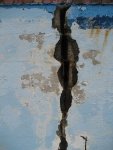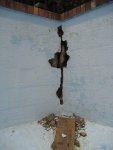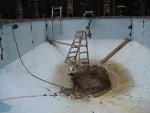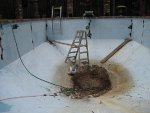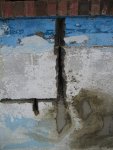Please take my advice with a HUGE grain of salt since I am in no way a pool builder or an expert. This is based on my pool remodel that was done by a pool builder. Looking at your pictures, it looks like they might have chiseled out your crack to make it bigger in order to be able to fill it in with cement. If it was a fine crack, it would be difficult to fill it with cement. From what I can recall, my pool company used concrete to patch the big crevice they chiseled out for my main drain and for my pool light. During the chiseling, they made sure that they did not damage any rebar. Then they just filled in the crevice with cement. For my main drain, they had to chisel out a pretty big section. I would say the "crevice" they created to run new plumbing was probably 15ft long by 1ft wide and deep enough that the crevice went all the way to the dirt. The pool light was a about a foot larger in diameter than the can that the light fits in and made contact with dirt as well. Now for the main drain, the concrete has some small aggregate stone. However for the light, it looked like it was just plain old portland cement without any aggregate stone. The pool guy told me that it was the plaster finish that made the pool waterproof, and not the cement. I assume that your paint is what is providing the waterproofing and not the concrete.
To be honest - I was surprise that they used the same stuff that you can buy at home depot. I thought they needed special "gunite" to patch in the holes and crevices. I honestly don't think that it really matter too much to them what type of cement they were using - they were using whatever they had on hand that day. If I was patching a small hole, i would have used hydraulic cement. The huge disadvantage of hydraulic cement is that it sets up VERY FAST. However, it is water proof.
What is Hydraulic Cement? Uses and How to Apply
Once again - please take my comment with a HUGE grain of salt as I am basing this on what I have seen and not on what I have actually done. And I can even be incorrect in what I saw.
- - - Updated - - -
Please take my advice with a HUGE grain of salt since I am in no way a pool builder or an expert. This is based on my pool remodel that was done by a pool builder. Looking at your pictures, it looks like they might have chiseled out your crack to make it bigger in order to be able to fill it in with cement. If it was a fine crack, it would be difficult to fill it with cement. From what I can recall, my pool company used concrete to patch the big crevice they chiseled out for my main drain and for my pool light. During the chiseling, they made sure that they did not damage any rebar. Then they just filled in the crevice with cement. For my main drain, they had to chisel out a pretty big section. I would say the "crevice" they created to run new plumbing was probably 15ft long by 1ft wide and deep enough that the crevice went all the way to the dirt. The pool light was a about a foot larger in diameter than the can that the light fits in and made contact with dirt as well. Now for the main drain, the concrete has some small aggregate stone. However for the light, it looked like it was just plain old portland cement without any aggregate stone. The pool guy told me that it was the plaster finish that made the pool waterproof, and not the cement. I assume that your paint is what is providing the waterproofing and not the concrete.
To be honest - I was surprise that they used the same stuff that you can buy at home depot. I thought they needed special "gunite" to patch in the holes and crevices. I honestly don't think that it really matter too much to them what type of cement they were using - they were using whatever they had on hand that day. If I was patching a small hole, i would have used hydraulic cement. The huge disadvantage of hydraulic cement is that it sets up VERY FAST. However, it is water proof. http://construction.about.com/od/Thermal-And-Moisture-Protectio/fl/What-is-Hydraulic-Cement-Uses-and-How-to-Apply.htm
Once again - please take my comment with a HUGE grain of salt as I am basing this on what I have seen and not on what I have actually done. And I can even be incorrect in what I saw.



